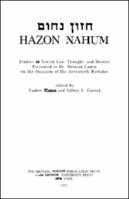Please use this identifier to cite or link to this item:
https://hdl.handle.net/20.500.12202/6143| Title: | Hesed: Divine or human? The syntactic ambiguity of Ruth 2:20. |
| Authors: | Cohen, Mordechai Z. Elman, Yaakov Gurock, Jeffrey https://orcid.org/0000-0003-1621-6116 |
| Keywords: | Ruth 2:20 biblical interpretation Jewish exegesis |
| Issue Date: | 1997 |
| Publisher: | New York, NY : Michael Sharf Publication Trust of the Yeshiva University Press ; Hoboken, NJ : distributed by Ktav, 1997. |
| Citation: | Cohen, M.Z. (1997). Hesed: Divine or human? The syntactic ambiguity of Ruth 2:20. In Y. Elman , & J. Gurock (Eds.), Hazon Nahum studies in Jewish law, thought, and history presented to Dr Norman Lamm on the occasion of his seventieth birthday (pp. 11-38). Michael Sharf Publication Trust of the Yeshiva University Press ; distributed by Ktav. |
| Series/Report no.: | Hazon Nahum;1997 |
| Abstract: | Clarity may be cherished by biblical interpreters; but ambiguity evokes their ingenuity, generating vibrant debate. Ruth 2:20, a turning point in the tale of two destitute widows who suddenly perceive a silver lining on their cloudy horizon, vividly illustrates this maxim... The exegetical tradition, culminating in modern scholarship, produced two viable readings of Ruth 2:20, but could interpret this verse no further. Literary criticism, which introduces the technique of intentional ambiguity, provides an environment in which readings A and B can coexist. The concept of dramatic irony further contributes a vocabulary for defining precisely how the two readings interact, forming a motivating force within the drama of Ruth, essential to its religious meaning. (from Introduction and Conclusion). |
| Description: | Scholarly article |
| URI: | https://hdl.handle.net/20.500.12202/6143 |
| ISBN: | 0881255998 |
| Appears in Collections: | Bernard Revel Graduate School of Jewish Studies (BRGS): Faculty Publications |
Files in This Item:
| File | Description | Size | Format | |
|---|---|---|---|---|
| cohenm_H Nahum_cohen_hesed_complete.pdf | 654.37 kB | Adobe PDF |  View/Open |
This item is licensed under a Creative Commons License

